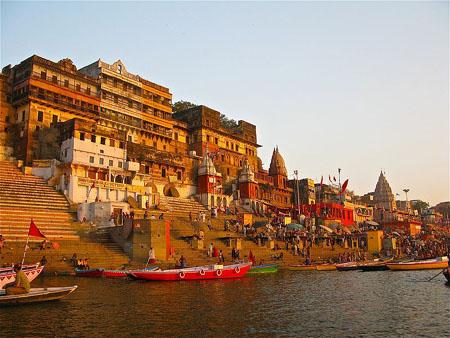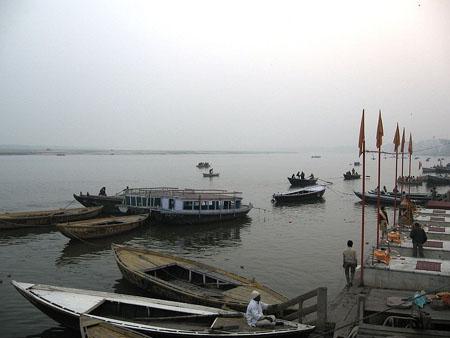Varanasi
The sacred city of the country India named Varanasi is situated in the Indian state of Uttar Pradesh. It is also called Kashi and Benaras. Some of the main characteristic features of Varanasi are its excellent silks, famous ‘paans’, the Benaras Hindu University and Avimukta and numerous places of worships. For the Hindu people, Varanasi holds utmost significance. It is considered to be one of the seven most sacred cities. It is also considered to be one of the Shakti Peethas and is counted as one of the twelve numbers of Jyotir Linga locations in India.
It is believed that Lord Shiva dwells here. The holy city of Benaras is set on the beds of the sacred River Ganges. As per myths, this location has the capability to sweep away anybody’s wrongdoings. The origin of Varanasi can be traces back to as many as 3000 years back, thus claiming it to be the most ancient city of the world. Hundreds and hundreds of temples are present here.
One of the major pilgrimage locations of Varanasi are the ghats of river Ganga. The sacred city of Varanasi reflects the elements of spiritualism, values and holiness for as many as numbers of years as one can remember. Guatama Buddha, Mahavira, Kabir, Tulsi Das, Shankaracharaya, Ramanuja and Patanjali are some of most celebrated and renowned saints and individuals hailing from this sacred city of Varanasi.
PLACES TO SEE
River Front (Ghats): The pavilions seen on the impressive river beds of Varanasi, dates back to the time period of 18th century and 19th century. There are also grand palaces, old temples and terraces, with numerous steps leading down to the ghats till the level of water of the river. A lingam is present in eac hand every ghat and contains some religious significance of its own. Some of them have demolished with time, while some are still standing in a grand manner. Pancha, (five) Trithi (crossing) of Asi, Dashashwamedha, Adi Keshva, Panchganga and finally Manikarnika forms the famous route, which many pilgrims traverse in the Panchatirthi Yatra.
Asi Ghat to Kedara Ghat: Situated in the extreme southern portion of Varanasi, the Asi Ghat is located on the convergence of Asi and Ganges. Before praying before a large lingam, which is situated below a peepal tree, people take bath in the river. Another popular lingam that the visitors go to see is the Asisangameshvara, who is known as the “Lord of the Confluence of the Asi”.
At present, the Lolarka Kund remains almost desolate; however during the time of the Lolarka Mela Fair, which takes place during the months of August and September, hundreds and hundreds of devotees come here to pray before the gods for a son. The Lolarka Kund is considered to be one of the most ancient locations of Varanasi. It is also one of the only two Sun locations related to the starting of Hinduism, which still remains.
The Tulsi Ghat, at present, has become almost demolished. The name of the ghat has been derived from the name of the famous poet Tulsidas. Initially, the name of this ghat was Lolarka Ghat. In the Hanuman Ghat, the huge South Indian group of people of the ghat has constructed a recent temple.
The Harishchandra Ghat has been named after the great king named Harishchandra. This ghat is one of the two of the cremation ghat of Varanasi. Kendra Ghat is situated further in the north direction.
Chauki Ghat to chausathi Ghat: A huge tree is a prominent feature of the Chauki Ghat. This tree provides refuge to the small temples of the nagas, who are the water-snake gods and goddesses. The Chausathi Ghat is located crossing the tiny ghats named Mansarovar Ghat and Narada Ghat. Here, at this ghat, one can climb up the steps made of stone in order to reach the temple of Chausathi Yoginis. One can also observe the grandiose haveli of Peshwa Amrit Rao. It has been constructed in th year 1807 overseeing the ghats. It has been built with sandstone. An auditorium for hosting concerts and religious events is also present here.
Dashashwamedha Ghat: The Dashashwamedha Ghat is situated beyond the structure, where the shrine of Shitala is present. Even in the monsoon months, during which the followers have to reach this place via boats, people come here in large numbers. It is the most famous and adored bathing ghat in Varanasi. The name of the ghat, that is, ‘ten horse sacrifices’, has been given to this place because of a convoluted set of sacrifices, which Brahma performed in order to check King Divodasa.
Man Mandir Ghat to Lalita Ghat: This ghat has been constructed for the Maharaja of Jaipur. The splendid and grandiose observatory belonging to the 18th century and the elaborate window casings are the reasons, that this place is renowned. One can pay their respect to Someshvara, the lord of the moon. A shrine of Vaishalakshi, who is called the ‘Wide Eyed Goddess’, is also present in the Mir Ghat. One can also pay a visit to the Dharma Kupa, the Well of Dharma. The Lalita Ghat is situated in the north direction. The presence of the Ganga Keshava Shrine of Vishnu and the Nepali Temple is the reason for which this place is famous.
Manikarnika Ghat: Manikarna Ghat is situated in the north direction of Lalita. It is a location where cremation takes place. It is intriguing for many visitors that how cremation takes place in such a public place. The Manikarna Ghat is located in the middle of the five tirthas. This ghat stands for two meanings, namely, creation and destruction. The holy well called Manikarnika Kund is also located here. It is believed that Vishnu is responsible for digging this well during the occasion of creation.
When the river water retreats and what remains is deposition of alluvial soil, the kund is then again excavated. Every year this event takes place. The environment is then washed free of dirt and trash and then painted with folk art in vibrant hues.
Scindia Ghat: The panoramic Scindia Ghat is situated in the north direction of Manikarnika, bounding it. Some of the most important worship places of this place are situated above the ghat. In the tangled web of lanes in the area called the Siddha Kshetra, one can find these shrines, hidden from the straight view. It is believed that this is the location, where Agni, the Lord of Fire, took birth here.
Panchganga Ghat to Adi Keshva Ghat: The biggest building of Varanasi, which is the majestic mosque of Alamgir, towers above the renowned Panchganga Ghat. This architecture is popularly known as Beni Madhav-ka-Darera. The minarets of the mosque have been reduced. It is located on the relics of the once renowned temples named the Bindu Madhava. It is a temple of Vishnu. Later it Aurangzeb demolished it and on its place, he built a mosque.
An intriguing collection of cells having three facades are present beside the river front. During the monsoon months, these cells remain under water. Several of these cells contain lingams, some contains Vishnu’s images and numerous of them serve as locations for doing yoga while some are just empty.
A sacred lingam of Three Eye Shiva is present above the ghat named Trilochana. The river Varna merges into the Ganga at the location named as the Adi Keshava Ghat, which is located in the exterior area of the city. In and around the Adi Keshva, one can find numerous shrines of Ganesha.
Vishwanatha Khanda: The location of the Vishwanatha Khanda is often denoted as the Old City. One can get lost in the intriguing worship places and lingams, which dots every nooks and also innumerable stalls. The compound of the Vishwanatha is known as the Golden Temple. The name has been given due to the presence of the spire containing huge gold plating.
The interior of the compound contains a shivalingam, which is considered to be one of the most significant shivalingams of India. The shivalingam is constructed with black stone having a plain texture and it has been positioned on a plinth made of silver. The temple, which is there at present, has been constructed in the year 1777. Queen Ahalya Bai Holkar of Indore was responsible for its construction.
After crossing the main road, in the north direction, one can observe the Razia’s Mosque. The existence of this structure can be traced back to the time period of 13th century. The Annapurna Bhavani Temple is also situated nearby. The temple has been constructed in the devotion of the supreme Shakti, the queen and divine mother.
The Kashi Vishwanath Temple: The temple has been constructed in the devotion of Lord Shiva. This is the very location, where for the very first time the initial jyotirlinga gushed through the crust layer of the earth and went in the directions of the heavens.
HOW TO REACH VARANASI
By Air: Babatpur has the closest air terminal. The distance of this airport from Varanasi is 22 Kms.
By Rail: Two of the significant railway junctions are at Varanasi and Mughal Sarai.
By Road: Well maintained roads connect Varanasi to other major locations of the country.





